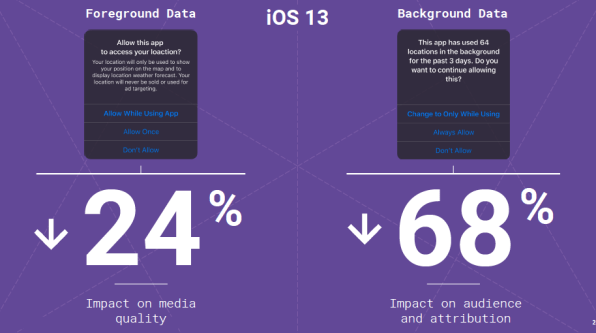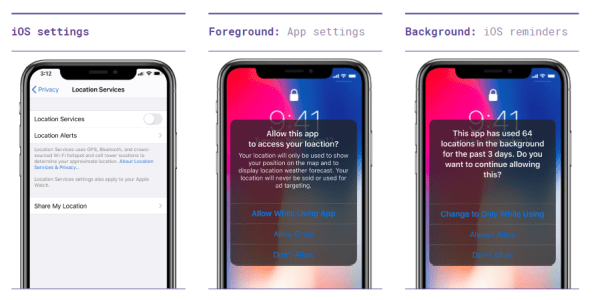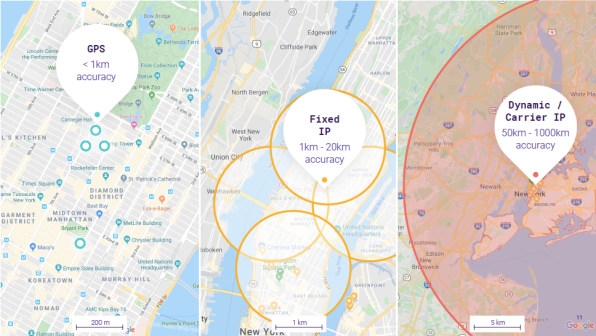Apple and Google’s tough new location privacy controls are working
Spare a thought, if you will, for the digital advertisers who have grown dependent on knowing your exact whereabouts at any instant.
New information shows that the biggest source for all this location data—namely, the smartphones that we carry around everywhere—is drying up as Apple and Google offer stronger, clearer privacy controls on their platforms.
Some recent data points to consider:
None of this means that location tracking is going away, but with more people opting out of sharing their precise location with apps, advertisers now have to make do with less accurate information. That in turn could make them rethink overly invasive tracking in the first place.

All about the options
With iOS, users have been able to stop any app from collecting location data in the background since 2017, but Apple gave this feature much more prominence in iOS 13. If an app is gathering location data while it’s not in use, iOS can show a pop-up with an option to cut off access. Apple also added a “just once” option in iOS 13 that requires apps to ask for location permission every time they’re opened.
“As those particular options were made available to users, we do attribute that to the decrease in sharing,” says Jason Smith, Location Sciences’ chief business officer.

Android’s location controls haven’t always been as useful, but the latest Android 10 release plays catchup with a similar “only while in use” setting when apps request location data. Like iOS, Android 10 also alerts users when an existing app collects location data in the background and provides a shortcut to stop the app from doing so.
These tools are becoming available just as we’re becoming more aware of how mobile apps have quietly trafficked users’ location histories. The New York Times, for instance, has reported on how apps like The Weather Channel, GasBuddy, and TheScore have collected detailed location data from users even while their apps aren’t in use, and it has documented how this supposedly anonymous data can pinpoint individuals based on their movements.
How apps will track you next
With Apple and Google providing less ready access to GPS location data, marketers will likely turn to IP addresses for location tracking instead, says Location Sciences’ Smith. Apps and websites can collect this data through the mobile or Wi-Fi network you’re using, and neither iOS nor Android offer any built-in controls to prevent it.
Still, IP addresses are less accurate than the precise GPS coordinates that apps had been collecting previously, which means marketers will have a tougher time tracking your precise whereabouts. In practical terms, that means location-based advertising will probably get a lot dumber in the near term, as marketers lose the ability to determine what store you visited or where you had lunch.
“You have an environment in which advertisers have been paying for—at a premium cost—high-quality, highly accurate GPS data,” Smith says. “They’re now confronted with a phenomenon in which that data is less available.”

Location Sciences’ angle in all of this is to sell tools that help advertisers know what kind of location data they’re purchasing. That way, they don’t waste money on inaccurate information. Other players in the ad tech business, however, are hoping for a more fundamental shift toward privacy.
We’re sort of at the precipice of this educational environment.”
Raman Sidhu, VP of business development for the marketing analytics firm Beemray, says the new tools in iOS and Android—along with new regulations such as Europe’s General Data Protection Regulation and the California Consumer Privacy Act—could be a wake-up call for a complacent industry.
“There are lot of different solutions now that are getting a lot of momentum, which previously wouldn’t have gotten any momentum because there was no reason for the agencies to think about something outside of the box,” Sidhu says.
One of those solutions, of course, could be Beemray, which rejects the idea of following people around and instead uses contextual clues (approximate location data among them) to predict which messages might resonate. As a basic example, someone who’s sitting at a desk in London and reading about travel might see an ad for direct flights to New York. Since the resulting ad wouldn’t be as hyper-targeted as what advertisers are used to, Sidhu expects that brands would have to focus more on production values, or on forging direct relationships with consumers who might provide data more willingly.
“Advertising should get better for consumers, because rather than being followed around with the same ads . . . the ad should be complementary to that user’s moods, moments, mindsets, and emotions,” Sidhu says.
The other possibility is that users will look to further protect their location histories through Virtual Private Networks (VPNs), which can mask the IP addresses on which advertisers are increasingly relying. Google already offers a VPN service for customers of its Google Fi cellular plans, and my colleague Michael Grothaus has called for Apple to build a VPN into iOS. Firefox has been experimenting with VPN service as well, and Amazon’s Eero routers offer VPN service through the Eero Secure+ subscription program. It’s not hard to imagine VPN becoming a standard feature on our phones, computers, and home networks in the future.
Location Sciences’ Smith says that’s one possibility among many as people become more privacy-conscious.
“We’re sort of at the precipice of this educational environment,” he says, “in which people are now becoming aware of what their options are, how those options impact the security that they will receive, and how other third-party companies are being respectful and mindful of those options.”
(44)



